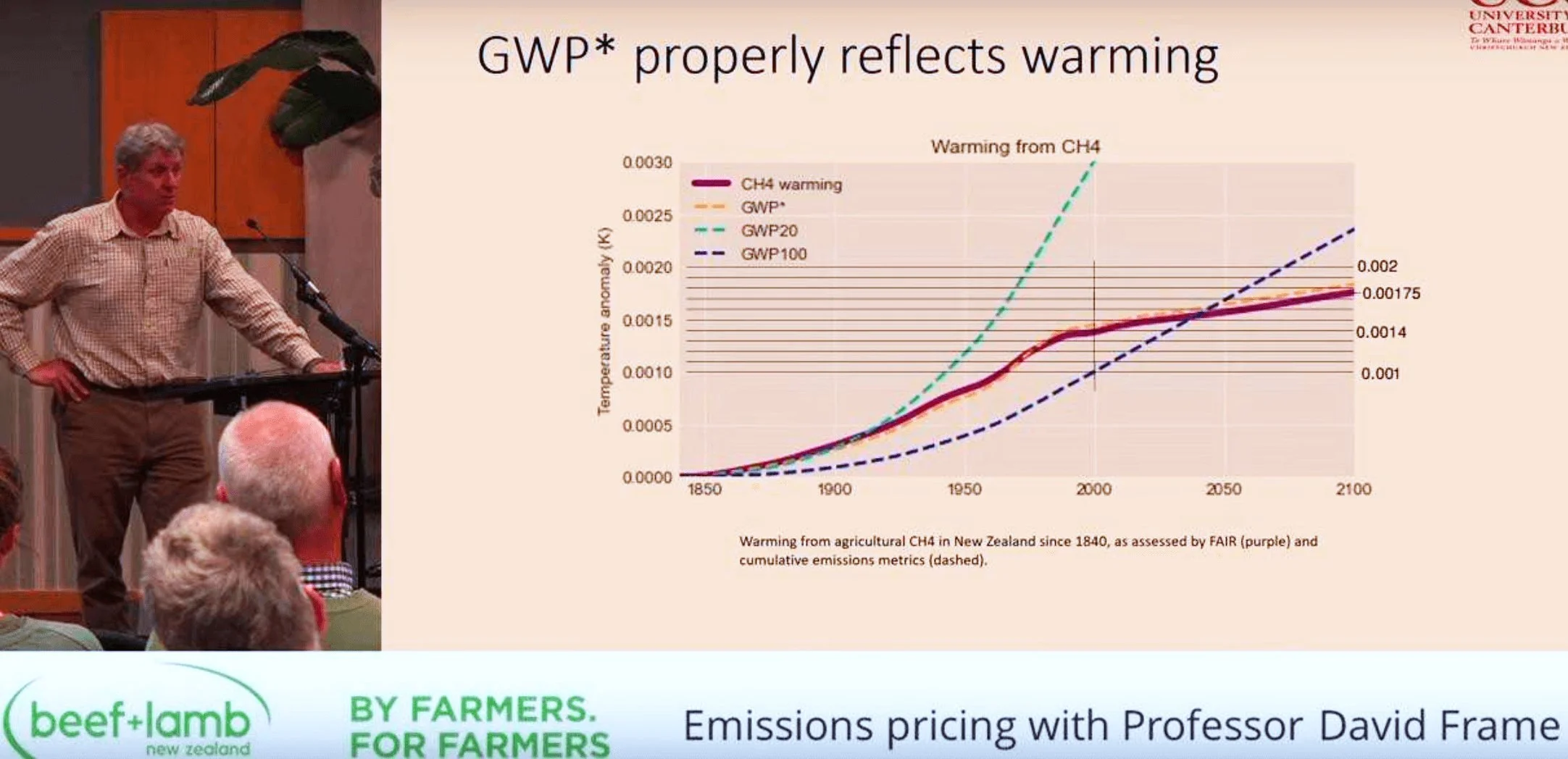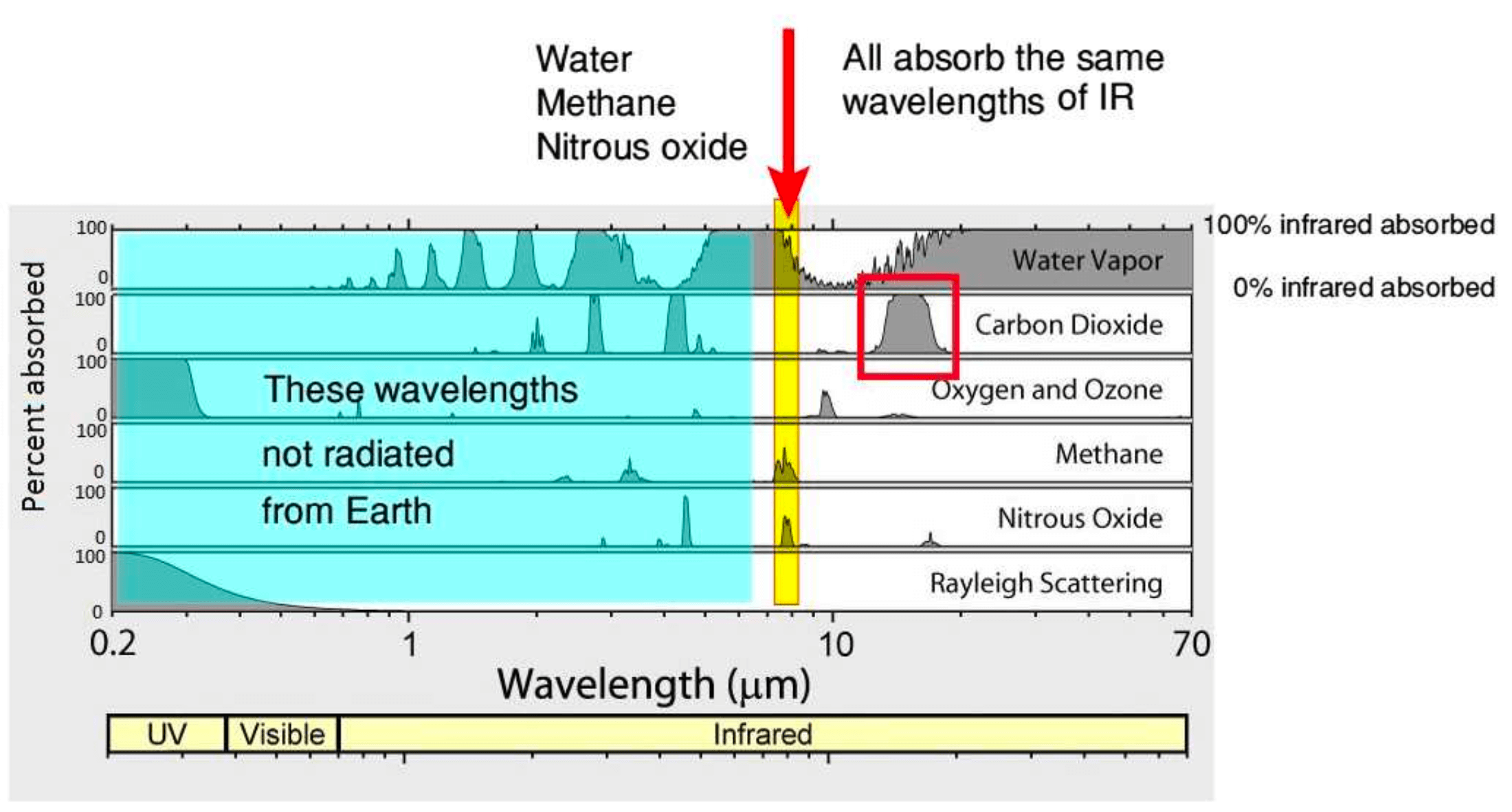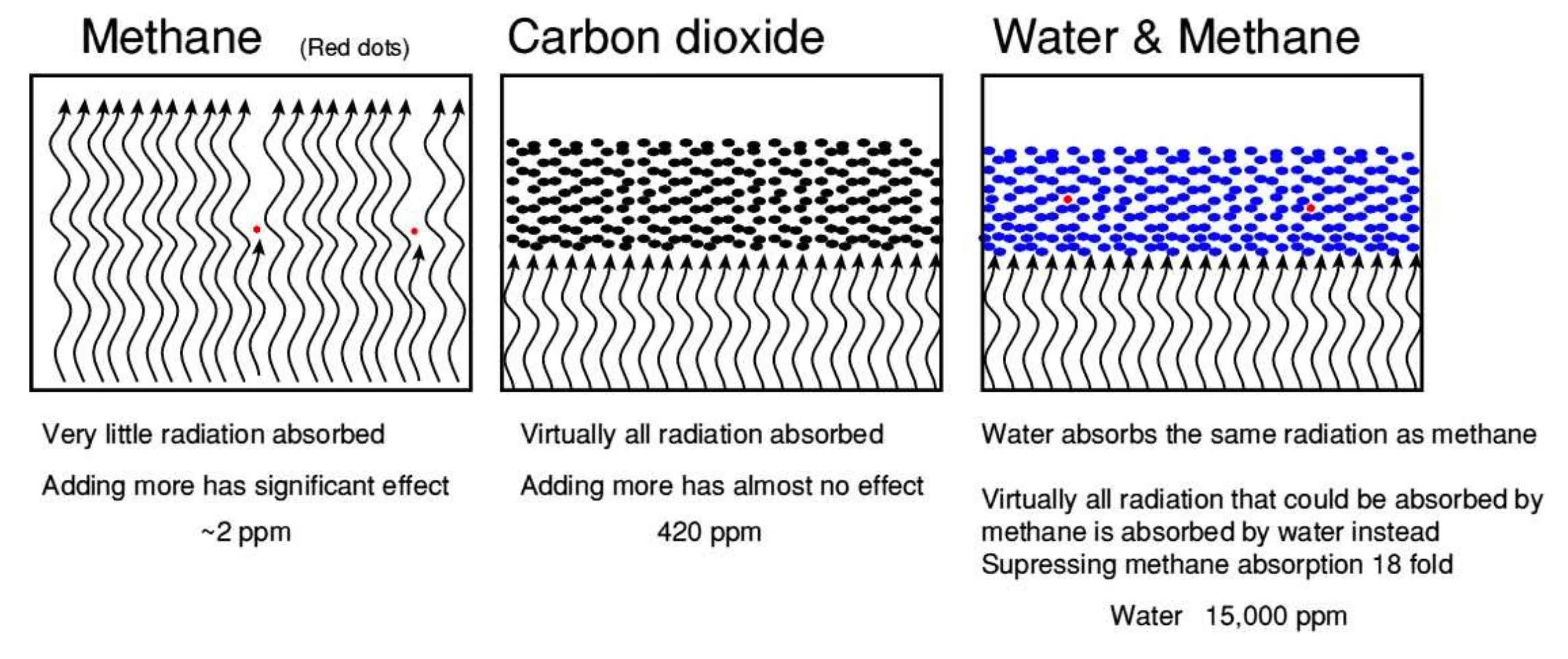Methane in New Zealand, A Beginner’s Guide to Methane 2
Part 2: Beginners Guide to METHANE
The Ministry for the Environment has stated that the cumulative warming in NZ from 1850 to 2022, caused by anthropogenic methane was 0.0021°C or 12 millionths of a degree per year.
In New Zealand, the methane from livestock has been calculated by Professor David Frame over the same period to be 0.0015°C. The difference 0.0006 °C coming from decomposition of rubbish.
The slowing of the rate of warming from livestock is due to the reduction in stock numbers that occurred in the 1990’s. In the 100 years from 2000 to 2100 his projection is for a warming of 0.0004°C or 4 millionths of a degree per year.
On these figures the projection of total NZ anthropogenic methane, going forward to 2100, would be 10 millionths of a degree per year. The margin of error for atmospheric temperature measurement is between 0.2 and 0.5°C, an average of 0.35°C. So if today was 20°C then in scientific terms it should be expressed as 20± 0.35°C.
At 10 millionths °C/year it would then take 35,000 years for warming from NZ methane to become measurable or 87,500 years for warming from NZ livestock to be measurable.
In order to reduce this figure our bureaucrats and politicians are prepared to destroy our agricultural industry that provides some 40% of NZ’s overseas earnings.
This is a madness beyond comprehension.
Conclusion - The warming from NZ methane is insignificant, unmeasureable and of no consequence to anybody.
What planet do our politicians and climate scientists live on?
When this was put to David Frame his response was that we all have to do our bit.?!
A Little Bit Of Science
On the electromagnetic spectrum, infrared is between the red end of the visible spectrum and microwave radiation. Infrared is shown in pink on the scale above.
Every object radiates infrared, you cannot see it but you feel it as heat. The wavelengths and intensity depend on the temperature of the radiating object.
Greenhouse Gases
Are gases in the atmosphere that can absorb and radiate certain wavelengths of infrared radiation. Leaves of plants for example, look green because the red and blue wavelengths of light arecabsorbed by chlorophyll in the leaves but green wavelengths are not, so the leaf reflects and transmits the green wavelengths.
Similarly, Greenhouse gases (GHG's) absorb some wavelengths but not others.
Note the window, in blue above where radiation from Earth is not absorbed by GHG's
Greenhouse gas absorption of outgoing longwave infrared radiation from the Earth
Some important things to note from the above chart.
• Water vapour, the main GHG, absorbs across most of the infrared range,
• Carbon dioxide and water absorb in the same range around 15 microns (µ) (millionths of a metre)
• The yellow band where water, methane and nitrous oxide all absorb the same wavelengths.
A particle of light energy is called a photon, the energy an individual photon has depends on its wavelength, the shorter the wavelength the more energy it has.
Some molecules can absorb certain wavelengths of electromagnetic radiation and be energised, they have gained a little more energy. However, within a millionth of a second they will radiate that energy again as a photon. Close to the Earth where molecules collide about a billion times per second it is more likely that they will lose that energy in collision with a non GHG, mostly either Nitrogen or oxygen. When the do that, the non GHG will come away from the collision with a little more energy in the form of faster movement, we perceive this as an increase in thermal energy or temperature. So the energy transferred to GHG's by radiation is passed onto other molecules as thermal (heat) energy. This is how GHG's warm the atmosphere. GHG's can also be energised by collision so throughout the atmosphere there is a constant exchange of energy between the non GHG's and GHG's
In the upper atmosphere the molecules are much further apart and so collision frequency is much lower so GHG's tend to lose their energy more by radiation, higher in the atmosphere upward directed radiation starts to escape to space.
Eventually all the energy absorbed by the Earth from sunlight must be radiated to space, if that did not happen then the Earth would cook. We are a ball in space and the only way (apart from Earths internal energy) that the Earth can warm or cool is by radiation.
Hope you are still with me. Now we have that basic stuff we can examine the other fallacies related to methane.
Global Warming Potential (GWP)
This was way of comparing the effect of various greenhouse gases invented by IPCC aligned scientists. However, it has some major flaws.
GWP is based on the difference in energy absorbed by GHG's coupled with the effect of how long a molecule lasts in the atmosphere. It compares the warming of each GHG relative to CO2 based on mass. So methane is 28 times worse over a hundred years but 85 times worse over 20 years. So what's not to like ?
Firstly, absorption of radiation is a property of molecules, the more molecules you have the more absorption. The problem is that methane is a much lighter molecule than CO2. So one tonne of methane has 2.75 times more molecules than a tonne of CO2
Hardly a fair comparison
Secondly, because there is very little methane in the air 1.9 ppm compared to 420 ppm for CO2 then most radiation bypasses methane so adding some more methane has a very large effect on the proportion of energy absorbed (left graphic). CO2 on the other hand, is saturated, that means that all the radiation from the Earth in the wavelengths that CO2 absorbs, are absorbed.
Adding more CO2 therefore has little effect (middle graphic above).
At present concentrations, adding one methane will absorb 30 times more energy than one CO2. The real problem is that when the IPCC does this calculation for methane it uses dry air, that is air devoid of water. Water absorbs the same wavelengths of radiation as methane and nitrous oxide so all the radiation that methane might absorb is absorbed by water as shown in diagram above (right), (methane is not in proportion here as there are some 8000 water/methane) The effect of this is that through the 85 kilometre column of air to space, absorption by methane is suppressed 18 fold but suppression is probably very much higher at the surface.
Thirdly, the IPCC takes longevity into account. They claim for example that CO2 last hundreds to thousands of years. However, their own charts show otherwise. Most papers in the scientific literature give 4 to 5 years for the longevity of CO2. Included in their longevity arguments is the concept that back radiation from GHG's warms the ocean. This is dealt with later.
The reason that they include longevity is that without it, it is impossible to explain how the 3% of CO2 put into the air from human activities can cause the increase in CO2 that has occurred over the last 75 years. Hence this claim is necessary in order to blame Humans for the increase in CO2.
This is a case of political imperatives turning science into pseudo-science.
Fourthly, the GWP ignores the the rate at which gases are increasing in the atmosphere.
The Earth is at a certain temperature due to GHG's. That temperature caused by GHG's can only increase if the concentration of GHG's is increased. The GWP and longevity arguments have no scientific validity, they were always there in order to blame humans for the increase in CO2 and the slight warming of the world.
GHG’s Warm the Oceans
Since 2004 the world has had accurate measurement of ocean temperatures down to 2 km across all the worlds oceans. Coupling that data with air temperatures has enabled scientists to get a good picture of the sequence of energy flow in the world.
All warming or cooling starts with the sea surface temperature and then moves to the atmosphere and deeper ocean.
BUT, the IPCC and the Methane Review Panel claim that back radiation from GHG’s in the air warm the ocean while scientists not aligned to the IPCC tell us that the oceans are warmed by the sun, increase sunlight and more warming results. Back radiation is radiation from GHG's in the atmosphere that is directed towards the Earth and so transfers energy downwards rather than upwards. If that radiation is absorbed by the oceans then they will be warmed by it.
Once again, the concept of back radiation warming the oceans is necessary if one wants to blame CO2 for warming the Earth.
We now know that that it is a physically impossible for the ocean to be heated by the atmosphere, for five reasons;
Longwave infrared radiation from CO2 can only penetrate the top 0.01mm or so of ocean surface compared to the many metres that sunlight can penetrate.
The photon path length is the average distance a photon travels before hitting a GHG. The path length for a photon released by CO2 is 20cm. It follows therefore that only back radiation in the half metre of air above the ocean could possibly be absorbed by the ocean, above that and the photon would be absorbed by another CO2 or water molecule.
For every photon hitting the water from the atmosphere, there are 83,000 being radiated into the atmosphere from the water. The energy transfer is clearly from the ocean to the atmosphere.
Specific heat of water is 4.18 kJ/kg/K while for moist air it is 1.005 kJ/kg/K or in simple language it takes 4 times more energy to heat a kilogram of water than it does to heat a kilogram of air. A kilogram of water is one litre of water, a kilogram of air is about 772 litres The air is not going to heat the water.
The ocean is warmer than the atmosphere. The ocean temperatures averaged ~20.6 °C in 2021 Atmospheric temperatures average ~18°C. The ocean will warm the atmosphere.
So what has caused the world to warm in recent decades
This chart comes from analyses of satellite measurement of radiation at the top of the atmosphere.
Follow these lines;
Outgoing shortwave radiation (yellow line) is light reflected from clouds and the earths surface. This has decreased over the last two decades due to cloud cover decreasing (confirmed by satellite measurements)
Incoming shortwave radiation (red line) is energy from the sun - it shows no significant change.
Outgoing longwave radiation. (blue line) is radiation from the surface of the Earth, it has increased as you would expect if there were more sunlight reaching the surface.
This graphic shows conclusively that recent warming has come from reduced cloud cover - nothing to do with CO2.
Conclusion - The atmosphere cannot heat the ocean. Therefore CO2 cannot be the agent of climate change as postulated by the IPCC.
Overall conclusion - methane is a non issue, its warming is so minuscule that no action is needed to reduce it. All proposed actions against methane are political and have no scientific validity.
Concluding Comments.
The conclusions reached above contradict everything you have ever heard about climate from the media and from “climate scientists”.
So who am I, Peter Foster, to make such claims. Well, I have not made any claims. Everything you have read above comes from the scientific literature. Science is based on the scientific method, that method requires that any hypothesis be supported by physical evidence. If it is not supported by evidence from observations, then it is wrong.
Science then amounts to the logical conclusions that one can come to on examination of the evidence.
So why do “climate scientists” tell a different story. The answer is simple, research institutes depend (mostly) on government handouts. When the US government was persuaded that CO2 was a problem then money flowed to science in a manner not seen since the second world war. Industry became involved with billions being directed to solar and wind. The methane review panel of IPCC acolytes were well aware that if their report said what I have said above, then the tap would be turned off and they would be pilloried by their numerous fellow scientists dependant on climate grants to keep their research going.
Consider the following statement from the IPCC 6th Assessment report.
“The signal of climate change has yet to emerge above natural variation for the following phenomena” It then lists every form of extreme weather bar one. So there is clearly no climate crisis.
That statement is also supported by global evidence of extreme weather (go to climate4you.com)
In late March 2025 a paper was published that used AI to check the scientific literatures support for CO2 driven climate change. the paper is here Article
One comment in the abstract states; (note that CMIP referred to are the climate models used by the IPCC)“Our analysis reveals that human CO2 emissions, constituting a mere 4% of the annual carbon cycle, are dwarfed by natural fluxes, with isotopic signatures and residence time data indicating negligible long-term atmospheric retention. Moreover, individual CMIP3 (2005-2006), CMIP5 (2010-2014), and CMIP6 (2013-2016) model runs consistently fail to replicate observed temperature trajectories and sea ice extent trends, exhibiting correlations (R²) near zero when compared to unadjusted records”.
It then says;
“We conclude that the anthropogenic CO2-Global Warming hypothesis lacks empirical substantiation, overshadowed by natural drivers such as temperature feedbacks and solar variability, necessitating a fundamental reevaluation of current climate paradigms”.
It is time to pull out of the Paris Agreement.
It is time to stop all Net Zero action.
It is time to repeal all climate related acts that impose hardship on people and businesses.
It is time to stop throwing our money at a non problem.
It is time to defund all those climate scientists who have routinely misrepresented the data, and misled the people of NZ
It is time to call out the media editors who in their ignorance have fostered climate hysteria.








